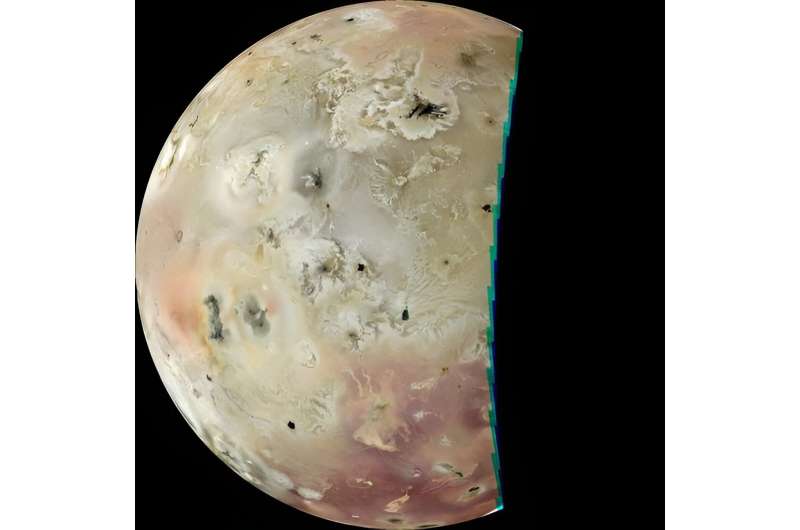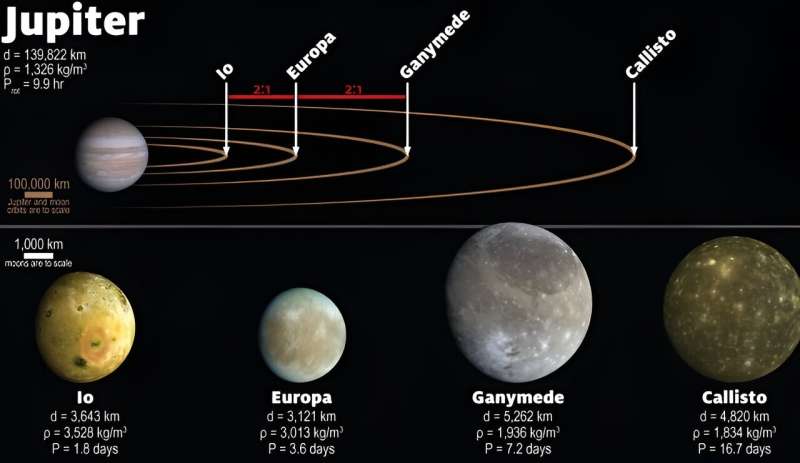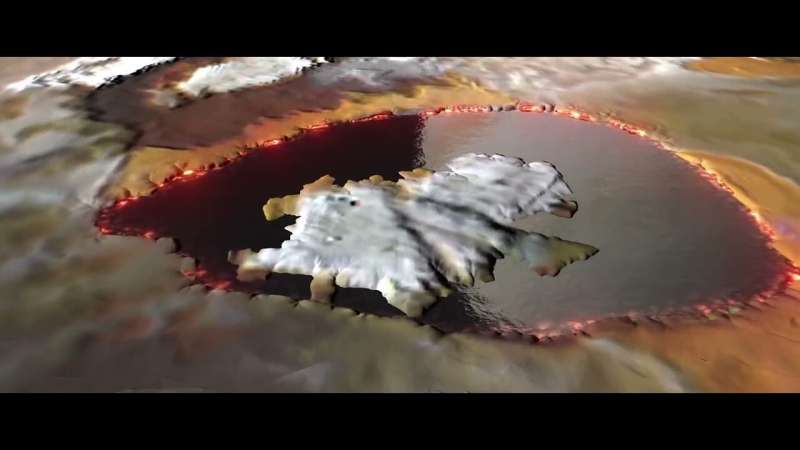Artist’s rendition of Lokipatra, the lava lake on Jupiter’s moon Io.Image source: NASA
NASA’s Juno spacecraft came within 1,500 kilometers (930 miles) of the surface of Jupiter’s moon Io during its two recent flybys. That’s close enough to reveal new details about the surface of the Moon, the most volcanic object in the solar system. Not only did Juno capture the volcanic activity, scientists were also able to use the data to create a visual animation showing what Io’s 200-kilometer-long lava lake Loki Patera would look like if it were closer. There are islands in the center of the lava lake, surrounded by hot lava. The surface of the lake is as smooth as glass and as smooth as obsidian.
“Io is full of volcanoes, and we found some of them that are active,” Juno principal investigator Scott Bolton told a press conference at the European Geophysical Union Congress in Vienna, Austria. “It’s fascinating. Amazing detail shows that these crazy islands are embedded in the center of a potential magma lake, surrounded by hot molten rock. Specular reflections from the lake recorded by our instruments suggest that parts of Io’s surface are as smooth as glass, reminiscent of glass. Obsidian glass formed on volcanoes.
Imagine if you could stand next to this lake – it’s a stunning view in itself. But then, you look up and see giant Jupiter looming in the sky above you.
Juno will make two close flybys of Io in December 2023 and February 2024. There’s no doubt that Io looks like a slice of pizza – that’s what we’ve concluded since the first time we’ve seen the moon since Voyager 1 flew by the Jupiter system in March 1979. There are hundreds of vents and calderas creating various features on the surface. Volcanic plumes and lava flows on the surface appear in a variety of colors, from red and yellow to orange and black. Some lava “rivers” stretch for hundreds of kilometers.
Juno scientists were also able to reconstruct a spectacular feature on Io, a pointed mountain nicknamed “The Spire.” The height of this feature is between 5 and 7 kilometers (3-4.3 miles). It’s hard to understand what kind of volcanic activity could create such stunning terrain.
Speaking of volcanism, two recent papers reached a jaw-dropping conclusion about Io: The moon has been erupting since the birth of the solar system.
All volcanic activity on Io is driven by tidal heating. Io is in orbital resonance with Jupiter’s other two large moons, Europa and Ganymede.
“Ganymede orbits Jupiter once, Europa orbits Jupiter twice, and Io orbits Jupiter four times,” explain the authors of a paper published in the journal Jupiter. Journal of Geophysical Research: Planets, led by Ery Hughes of GNS Science in New Zealand. “This situation could cause tidal heating of Io (much like how the moon causes ocean tides on Earth), which could trigger volcanic activity.”

During the Juno spacecraft’s 58th near-Jupiter flyby on February 3, 2024, Ios’ near-Jupiter hemisphere was revealed in detail for the first time since Voyager 1 flew by the Jupiter system in March 1979. Shows the night side of Ios illuminated by reflected sunlight leaving Jupiter’s cloud tops. Some notable surface changes include the reshaping of the complex flow field at Kanehekili (center left) and new lava flows east of Kanehekili. The pixel ratio of this image is 1.6 km/pixel. Image source: NASA/SwRI/JPL/MSSS/Jason Perry
However, scientists don’t yet know how long this resonance has been occurring, or whether what we observe today is what has always happened in the Jupiter system. That’s because volcanic activity almost constantly renews Io’s surface, leaving little trace of the past.
A team of scientists led by Caltech’s Katherine de Kleer and GNS Science’s Hughes used the Atacama Large Millimeter/submillimeter Array (ALMA) in Chile to observe sulfur-containing gases in Io’s atmosphere. Iotopes of sulfur are used as tracers of Io’s tidal heating because the sulfur is released through volcanism, processed in the atmosphere, and then recycled into the mantle. In addition, some of the sulfur is lost to space, thanks to Jupiter’s magnetosphere, a swarm of charged particles orbiting Jupiter that constantly slams into Io’s atmosphere.
It turns out that the sulfur lost to Io’s space is isotopically lighter than the sulfur recovered back into Io’s interior. Because of this, the remaining sulfur isotopes on Io have become heavier and heavier over time. How much it weighs depends on when the volcanic activity occurred.
The research team found that tidal heating on Io has occurred for billions of years.
“The isotopic composition of Io’s volatile chemical elements, including sulfur and chlorine, reflects its outgassing and mass loss history, thus recording information about its evolution,” the team wrote in a paper published in Io. message. science. “These results suggest that Io has been volcanically active for most (or all) of its history, and that rates of outgassing and mass loss may have been higher in the early years.”

Jupiter’s orbital system is commensurate with the size of the host planet and its orbit.Image credit: James Tuttle Keane/Keck Institute for Space Studies
Juno continues its journey through the Jupiter system. During Juno’s most recent flyby of Io on April 9, the spacecraft was about 16,500 kilometers (10,250 miles) from the lunar surface. It will conduct its 61st flyby of Jupiter on May 12.
JunoCam is a public camera that allows the public to select imaging targets and process all data. JunoCam’s raw images are available here for public viewing and processing into imaging products. Here you can see the latest images that have been processed.
More information:
Ery C. Hughes et al., Using Io’s sulfur isotope cycle to understand the history of tidal heating, Journal of Geophysical Research: Planets (2024). DOI: 10.1029/2023JE008086
Katherine de Kleer et al., Isotopic evidence for long-lasting volcanism on Io, science (2024). DOI: 10.1126/science.adj0625
Provided by Universe Today
citation: Juno reveals a giant lava lake on Io (2024, April 22), Retrieved April 23, 2024, from https://phys.org/news/2024-04-juno- reveals-giant-lava-lake.html
This document is protected by copyright. No part may be reproduced without written permission except in the interests of fair dealing for private study or research purposes. Content is for reference only.
#Juno #discovers #huge #lava #lake
Image Source : phys.org
